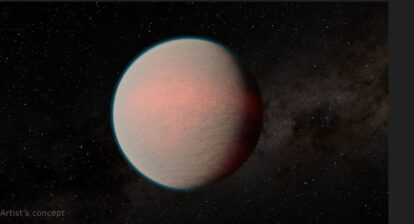On November 19, 2021 (late evening of the 18th in some time zones), there will be a near total lunar eclipse when the Moon passes into the Earth’s shadow and the Moon will turn red.
A lunar eclipse occurs when the Sun, Earth, and Moon align so that the Moon passes into the shadow of the Earth. In a total lunar eclipse, the entire Moon falls within the darkest part of Earth’s shadow, called the umbra. In this eclipse, up to 99.1% of the Moon’s disk will be within Earth’s umbra. Also, the whole event will last over six hours and the Moon will be under Earth’s shadow for almost three and a half hours. This will make it the longest partial lunar eclipse since 1441, as well as this century.

A world map showing where the eclipse is visible at the time of greatest eclipse. Earlier parts of the eclipse are visible farther east, while later times are visible farther west. Credit: NASA’s Scientific Visualization Studio
This potentially spectacular eclipse will be visible in North America, including Hawaii, parts of Russia and South America, while in Australia, New Zealand, Japan, China, and Southeast Asia it will be visible on the evening of Friday, 19 November. In the UK, it will be visible for a short period of time just before sunrise, at around 7:19am on Friday November 19, reaching maximum around 9am and ending at 10:47am. The best viewing will be right around the peak of the eclipse, on November 19th at 9:03 UTC/4:03 AM EDT/1:03 AM PDT.

Sunset in Liverpool. Rayleigh scattering. Image: 360onhistory.com
There is a reason why the Moon turns red during a lunar eclipse. It is because of a phenomenon known as Rayleigh scattering, which makes sunsets and sunrises red and orange. Light is made up of different colours (spectrum) and it travels in waves. Each colour of the light spectrum has different properties. Blue light has a shorter wavelength and on the opposite end of the spectrum, red light has a longer wavelength. Blue light’s shorter wavelength cause it to scatter more easily in the Earth’s atmosphere, while red light’s longer wavelength does not. During sunsets and sunrises, when the Sun is closer to the horizon, sunlight has to travel through a longer distance and more of a dense environment to reach an observer’s eye. Blue light scatters away and red, orange and yellow reach our eyes and we see the sunset as red or orange.
The same phenomenon occurs during a lunar eclipse. The Moon turns red because the only sunlight reaching the Moon passes through Earth’s atmosphere and if there are more dust particles or clouds in the atmosphere during the eclipse, the redder the Moon will appear.
Video Credit: NASA’s Scientific Visualization Studio



![This image shows a section of the side view of the Milky Way as measured by ESA’s Gaia satellite. The dark band consists of gas and dust, which dims the light from the embedded stars. The Galactic Centre of the Milky Way is indicated on the right of the image, shining brightly below the dark zone. The box to the left of the middle marks the location of the “Maggie” filament. It shows the distribution of atomic hydrogen. The colours indicate different velocities of the gas. [less] Image: ESA/Gaia/DPAC, CC BY-SA 3.0 IGO & T. Müller/J. Syed/MPIA](https://www.360onhistory.com/wp-content/uploads/2022/01/mpia-pr_maggie_syed_2021_teaser_16x9-414x224.jpg)


